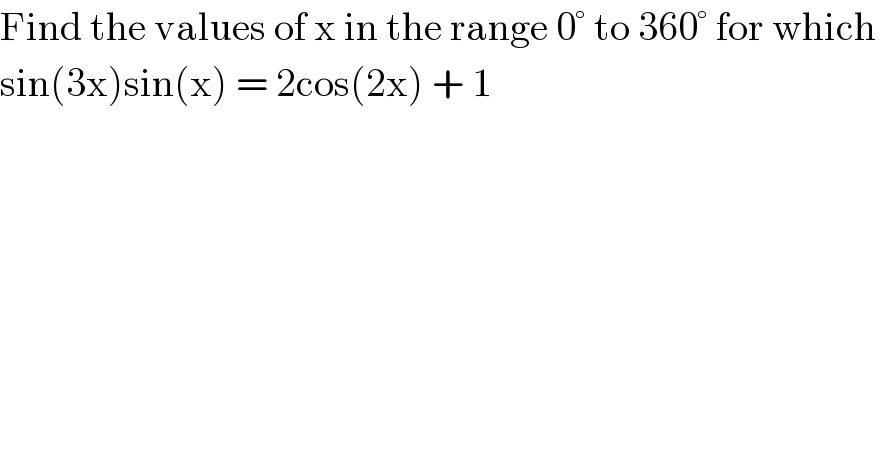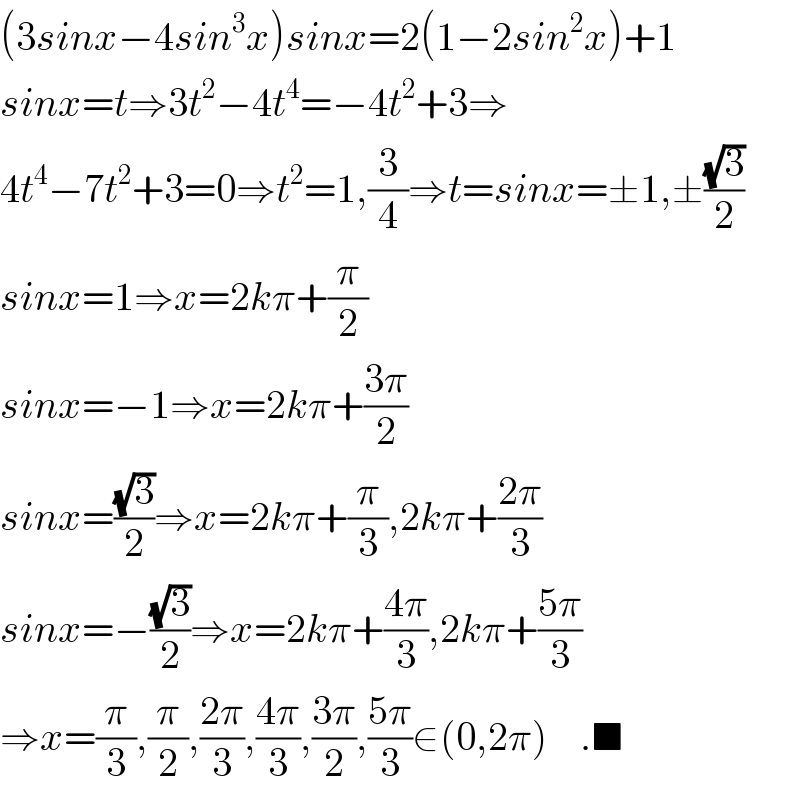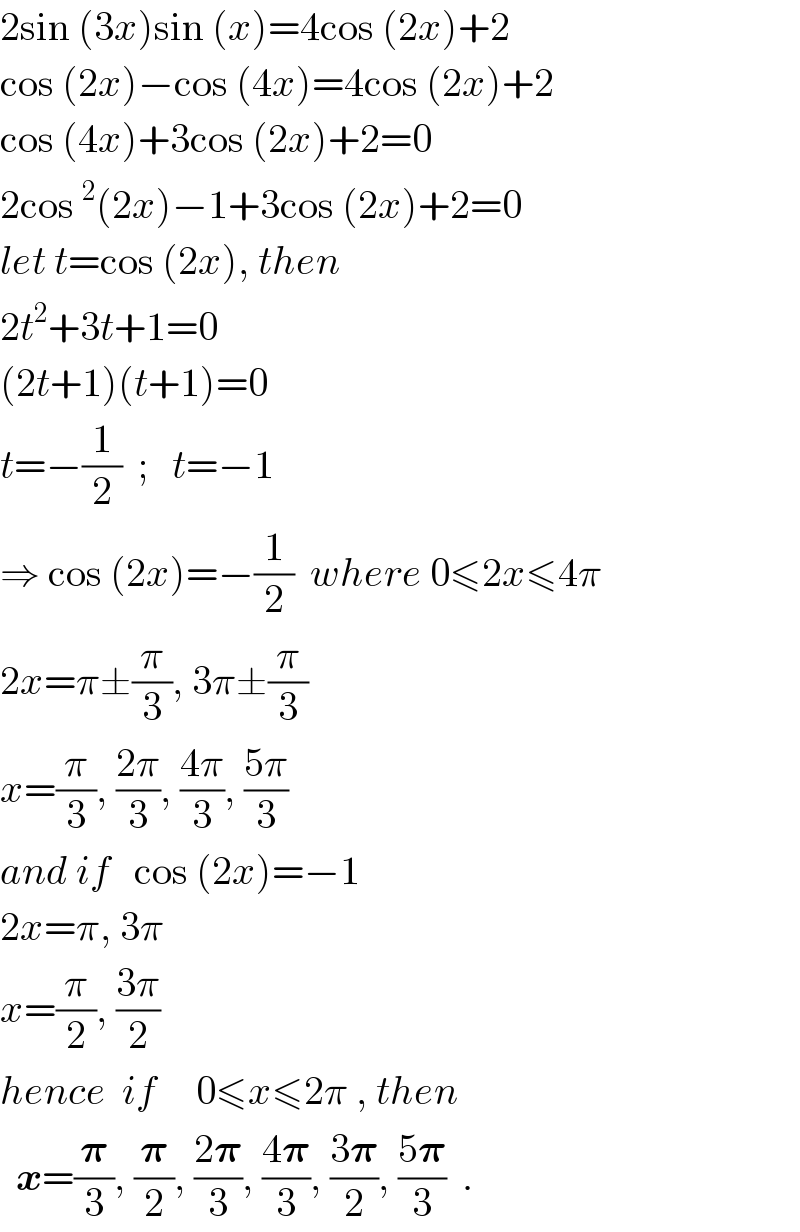
Question Number 13903 by tawa tawa last updated on 24/May/17

$$\mathrm{Find}\:\mathrm{the}\:\mathrm{values}\:\mathrm{of}\:\mathrm{x}\:\mathrm{in}\:\mathrm{the}\:\mathrm{range}\:\mathrm{0}°\:\mathrm{to}\:\mathrm{360}°\:\mathrm{for}\:\mathrm{which}\: \\ $$$$\mathrm{sin}\left(\mathrm{3x}\right)\mathrm{sin}\left(\mathrm{x}\right)\:=\:\mathrm{2cos}\left(\mathrm{2x}\right)\:+\:\mathrm{1} \\ $$
Commented by myintkhaing last updated on 26/May/17

$${Please}\:{in}\:{the}\:{range}\:\mathrm{0}°\:{to}\:\mathrm{360}°\:{means} \\ $$$$\mathrm{0}°<{x}<\mathrm{360}°\:{or}\:\mathrm{0}°\leqslant{x}\leqslant\mathrm{360}°\:?? \\ $$
Answered by b.e.h.i.8.3.4.1.7@gmail.com last updated on 25/May/17

$$\left(\mathrm{3}{sinx}−\mathrm{4}{sin}^{\mathrm{3}} {x}\right){sinx}=\mathrm{2}\left(\mathrm{1}−\mathrm{2}{sin}^{\mathrm{2}} {x}\right)+\mathrm{1} \\ $$$${sinx}={t}\Rightarrow\mathrm{3}{t}^{\mathrm{2}} −\mathrm{4}{t}^{\mathrm{4}} =−\mathrm{4}{t}^{\mathrm{2}} +\mathrm{3}\Rightarrow \\ $$$$\mathrm{4}{t}^{\mathrm{4}} −\mathrm{7}{t}^{\mathrm{2}} +\mathrm{3}=\mathrm{0}\Rightarrow{t}^{\mathrm{2}} =\mathrm{1},\frac{\mathrm{3}}{\mathrm{4}}\Rightarrow{t}={sinx}=\pm\mathrm{1},\pm\frac{\sqrt{\mathrm{3}}}{\mathrm{2}} \\ $$$${sinx}=\mathrm{1}\Rightarrow{x}=\mathrm{2}{k}\pi+\frac{\pi}{\mathrm{2}} \\ $$$${sinx}=−\mathrm{1}\Rightarrow{x}=\mathrm{2}{k}\pi+\frac{\mathrm{3}\pi}{\mathrm{2}} \\ $$$${sinx}=\frac{\sqrt{\mathrm{3}}}{\mathrm{2}}\Rightarrow{x}=\mathrm{2}{k}\pi+\frac{\pi}{\mathrm{3}},\mathrm{2}{k}\pi+\frac{\mathrm{2}\pi}{\mathrm{3}} \\ $$$${sinx}=−\frac{\sqrt{\mathrm{3}}}{\mathrm{2}}\Rightarrow{x}=\mathrm{2}{k}\pi+\frac{\mathrm{4}\pi}{\mathrm{3}},\mathrm{2}{k}\pi+\frac{\mathrm{5}\pi}{\mathrm{3}} \\ $$$$\Rightarrow{x}=\frac{\pi}{\mathrm{3}},\frac{\pi}{\mathrm{2}},\frac{\mathrm{2}\pi}{\mathrm{3}},\frac{\mathrm{4}\pi}{\mathrm{3}},\frac{\mathrm{3}\pi}{\mathrm{2}},\frac{\mathrm{5}\pi}{\mathrm{3}}\in\left(\mathrm{0},\mathrm{2}\pi\right)\:\:\:\:.\blacksquare \\ $$
Commented by tawa tawa last updated on 25/May/17

$$\mathrm{God}\:\mathrm{bless}\:\mathrm{you}\:\mathrm{sir}. \\ $$
Commented by ajfour last updated on 25/May/17

$${i}\:{think}\:\:\:{x}=\frac{\mathrm{2}\pi}{\mathrm{3}},\:\frac{\mathrm{5}\pi}{\mathrm{3}}\:{also}\:{qualify}\: \\ $$$${in}\:{the}\:{given}\:{range}\:. \\ $$
Commented by b.e.h.i.8.3.4.1.7@gmail.com last updated on 25/May/17

$${you}\:{are}\:{right}\:{sir}.{thanks}. \\ $$
Answered by ajfour last updated on 25/May/17

$$\mathrm{2sin}\:\left(\mathrm{3}{x}\right)\mathrm{sin}\:\left({x}\right)=\mathrm{4cos}\:\left(\mathrm{2}{x}\right)+\mathrm{2} \\ $$$$\mathrm{cos}\:\left(\mathrm{2}{x}\right)−\mathrm{cos}\:\left(\mathrm{4}{x}\right)=\mathrm{4cos}\:\left(\mathrm{2}{x}\right)+\mathrm{2} \\ $$$$\mathrm{cos}\:\left(\mathrm{4}{x}\right)+\mathrm{3cos}\:\left(\mathrm{2}{x}\right)+\mathrm{2}=\mathrm{0} \\ $$$$\mathrm{2cos}\:^{\mathrm{2}} \left(\mathrm{2}{x}\right)−\mathrm{1}+\mathrm{3cos}\:\left(\mathrm{2}{x}\right)+\mathrm{2}=\mathrm{0} \\ $$$${let}\:{t}=\mathrm{cos}\:\left(\mathrm{2}{x}\right),\:{then} \\ $$$$\mathrm{2}{t}^{\mathrm{2}} +\mathrm{3}{t}+\mathrm{1}=\mathrm{0} \\ $$$$\left(\mathrm{2}{t}+\mathrm{1}\right)\left({t}+\mathrm{1}\right)=\mathrm{0} \\ $$$${t}=−\frac{\mathrm{1}}{\mathrm{2}}\:\:;\:\:\:{t}=−\mathrm{1} \\ $$$$\Rightarrow\:\mathrm{cos}\:\left(\mathrm{2}{x}\right)=−\frac{\mathrm{1}}{\mathrm{2}}\:\:{where}\:\mathrm{0}\leqslant\mathrm{2}{x}\leqslant\mathrm{4}\pi \\ $$$$\mathrm{2}{x}=\pi\pm\frac{\pi}{\mathrm{3}},\:\mathrm{3}\pi\pm\frac{\pi}{\mathrm{3}} \\ $$$${x}=\frac{\pi}{\mathrm{3}},\:\frac{\mathrm{2}\pi}{\mathrm{3}},\:\frac{\mathrm{4}\pi}{\mathrm{3}},\:\frac{\mathrm{5}\pi}{\mathrm{3}} \\ $$$${and}\:{if}\:\:\:\mathrm{cos}\:\left(\mathrm{2}{x}\right)=−\mathrm{1} \\ $$$$\mathrm{2}{x}=\pi,\:\mathrm{3}\pi \\ $$$${x}=\frac{\pi}{\mathrm{2}},\:\frac{\mathrm{3}\pi}{\mathrm{2}} \\ $$$${hence}\:\:{if}\:\:\:\:\:\mathrm{0}\leqslant{x}\leqslant\mathrm{2}\pi\:,\:{then} \\ $$$$\:\:\boldsymbol{{x}}=\frac{\boldsymbol{\pi}}{\mathrm{3}},\:\frac{\boldsymbol{\pi}}{\mathrm{2}},\:\frac{\mathrm{2}\boldsymbol{\pi}}{\mathrm{3}},\:\frac{\mathrm{4}\boldsymbol{\pi}}{\mathrm{3}},\:\frac{\mathrm{3}\boldsymbol{\pi}}{\mathrm{2}},\:\frac{\mathrm{5}\boldsymbol{\pi}}{\mathrm{3}}\:\:. \\ $$
Commented by mrW1 last updated on 25/May/17

$${yes},\:{there}\:{are}\:\mathrm{6}\:{solutions}\:{in}\:{the} \\ $$$${range}\:\left(\mathrm{0},\:\mathrm{2}\pi\right) \\ $$
Commented by ajfour last updated on 25/May/17

$${thanks}.\: \\ $$
